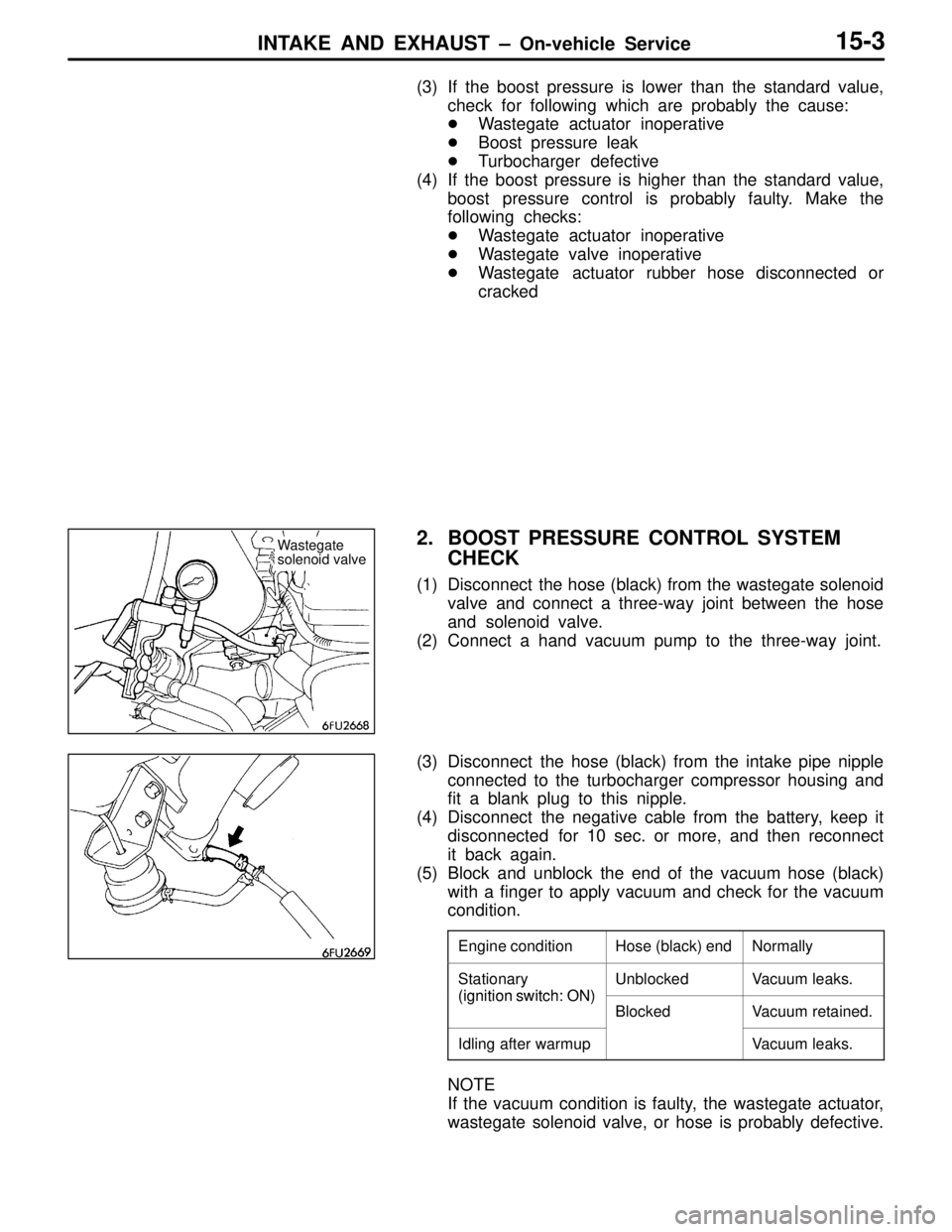Page 82 of 396
ENGINE COOLING – Service Specifications / Lubricant / On-vehicle Service14-2
SERVICE SPECIFICATIONS
ItemsStandard value
Thermostat valve opening temperature �CWhen open76.5 ± 1.5
When fully open90
Thermostat lift mm8.5 or more
LUBRICANT
ItemsBrandQuantity dm3 {�}
Coolant capacity (in condenser tank)MITSUBISHI GENUINE DIA QUEEN SUPER
LONG LIFE COOLANT6 {6}
ON-VEHICLE SERVICE
COOLANT REPLACEMENT
CYLINDER BLOCK DRAIN PLUG
Unit: Nm {kgf�m}
Drying sealant: HELMESEAL H-1M
44 {4.5}
RADIATOR CAP VALVE OPENING PRESSURE
CHECK
On EVOLUTION-V, the radiator cap valve opening pressure
must be as shown below.
Standard value: 93 – 123 kPa {0.95 – 1.25 kgf/cm
2}
Limit: 83 kPa {0.85 kgf/cm
2}
Page 83 of 396
ENGINE COOLING – Thermostat14-3
THERMOSTAT
REMOVAL AND INSTALLATION
Pre-removal and Post-installation Operation
�Engine Coolant Draining and Supplying
(Refer to P.14-2.)
�Air Intake Hose Assembly Removal and Installation
(Refer to GROUP 15 – Intercooler.)
4 3
5
1
Unit: Nm {kgf�m}
13 {1.3}
Removal steps
�A��B�1. Radiator lower hose connection
2. Control wiring harness connection
3. Water inlet fitting
�A�4. Thermostat
REMOVAL SERVICE POINT
�A�RADIATOR LOWER HOSE DISCONNECTION
After making mating marks on the radiator hose and the hose
clamp, disconnect the radiator hose.
Page 84 of 396

ENGINE COOLING – Thermostat14-4
INSTALLATION SERVICE POINTS
�A�THERMOSTAT INSTALLATION
(1) Install the thermostat so that the jiggle valve is facing
straight up.
Caution
Make absolutely sure that no oil is adhering to the
rubber ring of the thermostat. If the rubber ring is
damaged, replace the thermostat.
(2) When assembling the thermostat, be careful not to fold
over or scratch the rubber ring.
�B�RADIATOR LOWER HOSE CONNECTION
(1) Insert each hose as far as the projection of the water
inlet fitting.
(2) Align the mating marks on the radiator hose and hose
clamp, and then connect the radiator hose.
INSPECTION
THERMOSTAT CHECK
(1) Immerse the thermostat in water, and heat the water while
stirring. Check the thermostat valve opening temperature.
Standard value: 76.5 ± 1.5�C
(2) Check that the amount of valve lift is at the standard
value when the water is at the full-opening temperature.
Standard value:
Full-opening temperature: 90�C
Amount of valve lift: 8.5 mm or more
NOTE
Measure the valve height when the thermostat is fully
closed, calculate the valve lift by subtracting this
measurement from the valve height when the thermostat
is fully open.
Jiggle valve
Rubber ring
Valve lift
Page 85 of 396
ENGINE COOLING – Water Pump14-5
WATER PUMP
REMOVAL AND INSTALLATION
Pre-removal and Post-installation Operation
�Engine Coolant Draining and Supplying
(Refer to P.14-2.)�Timing Belt and Timing Belt B Removal and Installation
(Refer to GROUP 11.)
12 – 15 {1.2 – 1.5} 24 {2.4}
8 × 22 8 × 14
Bolt specifications
8 × 24
Screw diameter × length mm
1
2
4
3
2
22 {2.2}
8 × 70
Unit: Nm {kgf�m}
Removal steps
1. Alternator brace
2. Water pump
3. Water pump gasket
�A�4. O-ring
INSTALLATION SERVICE POINT
�A�O-RING INSTALLATION
Fit the O-ring in the O-ring groove in the water inlet pipe,
and coat the outer circumference of the O-ring or the inside
surface of the water pump with water before inserting the
pipe.
Water pump
O-ring
Water inlet pipe
Page 88 of 396
ENGINE COOLING – Radiator14-8
REMOVAL SERVICE POINTS
�A�RADIATOR UPPER HOSE / RADIATOR LOWER
HOSE DISCONNECTION
After making mating marks on the radiator hose and the hose
clamp, disconnect the radiator hose.
INSTALLATION SERVICE POINT
�A�RADIATOR LOWER HOSE / RADIATOR UPPER
HOSE CONNECTION
(1) Insert each hose as far as the projection of the water
inlet or outlet fitting.
(2) Align the mating marks on the radiator hose and hose
clamp, and then connect the radiator hose.
Caution
Fit the clamp on the hose at the same position as
before.
INSPECTION
1. RADIATOR FAN MOTOR CHECK
Apply the battery voltage across connector terminals 1 and
2, and terminals 3 and 4, of the radiator fan motor and check,
at that time, that the radiator fan turns.
2. POWER RELAY CONTINUITY CHECK
Battery voltageTerminal number
1345
When deenergized
When energized
Radiator fan motor relay LO
Page 90 of 396

15-1
INTAKE AND
EXHAUST
CONTENTS
SERVICE SPECIFICATIONS 2. . . . . . . . . . . . . .
SPECIAL TOOL 2. . . . . . . . . . . . . . . . . . . . . . . . .
ON-VEHICLE SERVICE 2. . . . . . . . . . . . . . . . . .
1. Turbocharger Boost Pressure Check 2. . . .
2. Boost Pressure Control System Check 3. .
3. Wastegate Actuator Check 4. . . . . . . . . . . . .
4. Wastegate Solenoid Valve Check 4. . . . . . .
5. Air Bypass Valve Check 4. . . . . . . . . . . . . . .
6. Secondary Air Control System Check 5. . .
7. Secondary Air Control Solenoid Valve
Check 5. . . . . . . . . . . . . . . . . . . . . . . . . . . . . . . . 8. Secondary Air Valve Check 6. . . . . . . . . . . .
9. Vacuum Tank Check 6. . . . . . . . . . . . . . . . . . .
INTERCOOLER 7. . . . . . . . . . . . . . . . . . . . . . . . . .
AIR CONTROL VALVE 8. . . . . . . . . . . . . . . . . . .
INTAKE MANIFOLD 9. . . . . . . . . . . . . . . . . . . . . .
EXHAUST MANIFOLD AND
TURBOCHARGER 11. . . . . . . . . . . . . . . . . . . . . .
EXHAUST PIPE AND MUFFLER 14. . . . . . . .
Page 91 of 396

INTAKE AND EXHAUST –
Service Specifications /
Special Tool / On-vehicle Service15-2
SERVICE SPECIFICATIONS
ItemsStandard valueLimit
Turbocharger boost pressure kPa {kg/cm2}53 – 87 {0.54 – 0.89}–
Wastegate actuator activation pressure kPa {kg/cm2}Approx. 100 {1.02}–
Wastegate solenoid valve coil resistance (at 20�C) Ω62 – 74–
Air bypass valve activation pressure kPa {mmHg}Approx. 53 {400}–
Secondary air control solenoid valve coil resistance (at 20�C) Ω28 – 36–
Intake manifold and exhaust manifold mounting surface distortion
mmWithin 0.150.20
SPECIAL TOOL
ToolNumberNameApplication
MB998770Oxygen sensor
wrenchRemoval and installation of oxygen sensor
ON-VEHICLE SERVICE
1. TURBOCHARGER BOOST PRESSURE
CHECK
Caution
Carry out driving tests in a location where full-throttle
acceleration is possible with utmost safety. Two persons
should be in the vehicle during the test, the assistant
in the front passenger seat reading the pressure gauge.
(1) Disconnect the hose (black) from the boost pressure
control solenoid valve and fit the pressure gauge to this
hose.
After the hose (black) has been disconnected, fit a blank
plug to the solenoid valve nipple.
(2) Drive at full-throttle acceleration in second gear and
measure the boost pressure when the engine speed
exceeds about 3,000 r/min.
Standard value:
53 – 87 kPa {0.54 – 0.89 kg/cm
2}
59 – 84 kPa {0.61 – 0.86 kg/cm2}
Wastegate
solenoid valve
Blank plug
Page 92 of 396

INTAKE AND EXHAUST – On-vehicle Service15-3
(3) If the boost pressure is lower than the standard value,
check for following which are probably the cause:
�Wastegate actuator inoperative
�Boost pressure leak
�Turbocharger defective
(4) If the boost pressure is higher than the standard value,
boost pressure control is probably faulty. Make the
following checks:
�Wastegate actuator inoperative
�Wastegate valve inoperative
�Wastegate actuator rubber hose disconnected or
cracked
2. BOOST PRESSURE CONTROL SYSTEM
CHECK
(1) Disconnect the hose (black) from the wastegate solenoid
valve and connect a three-way joint between the hose
and solenoid valve.
(2) Connect a hand vacuum pump to the three-way joint.
(3) Disconnect the hose (black) from the intake pipe nipple
connected to the turbocharger compressor housing and
fit a blank plug to this nipple.
(4) Disconnect the negative cable from the battery, keep it
disconnected for 10 sec. or more, and then reconnect
it back again.
(5) Block and unblock the end of the vacuum hose (black)
with a finger to apply vacuum and check for the vacuum
condition.
Engine conditionHose (black) endNormally
Stationary
(ignition switch: ON)
UnblockedVacuum leaks.
(ignition switch: ON)
BlockedVacuum retained.
Idling after warmupVacuum leaks.
NOTE
If the vacuum condition is faulty, the wastegate actuator,
wastegate solenoid valve, or hose is probably defective.
Wastegate
solenoid valve